heating FORD THUNDERBIRD 2003 11.G Owners Manual
[x] Cancel search | Manufacturer: FORD, Model Year: 2003, Model line: THUNDERBIRD, Model: FORD THUNDERBIRD 2003 11.GPages: 200, PDF Size: 1.79 MB
Page 12 of 200
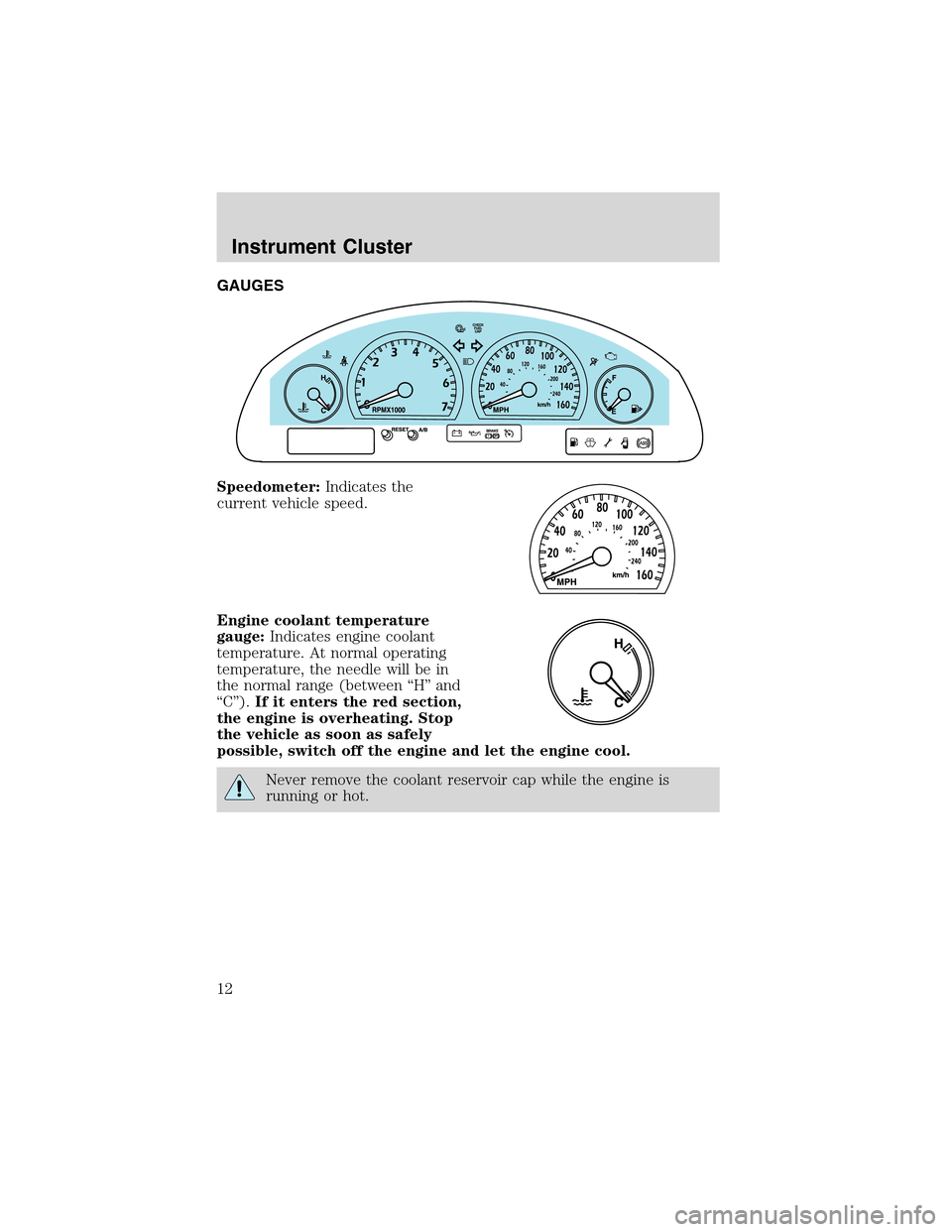
GAUGES
Speedometer:Indicates the
current vehicle speed.
Engine coolant temperature
gauge:Indicates engine coolant
temperature. At normal operating
temperature, the needle will be in
the normal range (between“H”and
“C”).If it enters the red section,
the engine is overheating. Stop
the vehicle as soon as safely
possible, switch off the engine and let the engine cool.
Never remove the coolant reservoir cap while the engine is
running or hot.
Instrument Cluster
12
Page 69 of 200
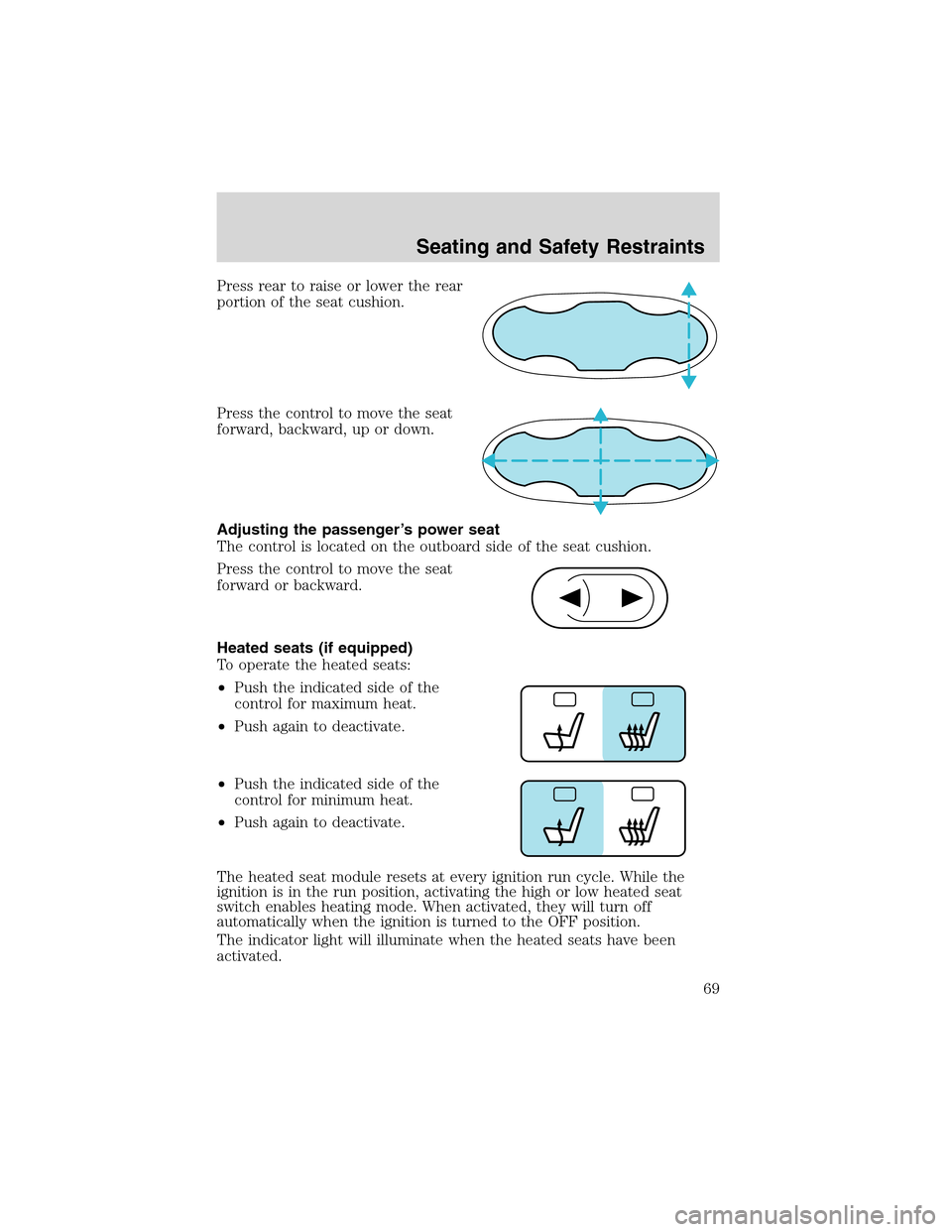
Press rear to raise or lower the rear
portion of the seat cushion.
Press the control to move the seat
forward, backward, up or down.
Adjusting the passenger’s power seat
The control is located on the outboard side of the seat cushion.
Press the control to move the seat
forward or backward.
Heated seats (if equipped)
To operate the heated seats:
•Push the indicated side of the
control for maximum heat.
•Push again to deactivate.
•Push the indicated side of the
control for minimum heat.
•Push again to deactivate.
The heated seat module resets at every ignition run cycle. While the
ignition is in the run position, activating the high or low heated seat
switch enables heating mode. When activated, they will turn off
automatically when the ignition is turned to the OFF position.
The indicator light will illuminate when the heated seats have been
activated.
Seating and Safety Restraints
69
Page 105 of 200
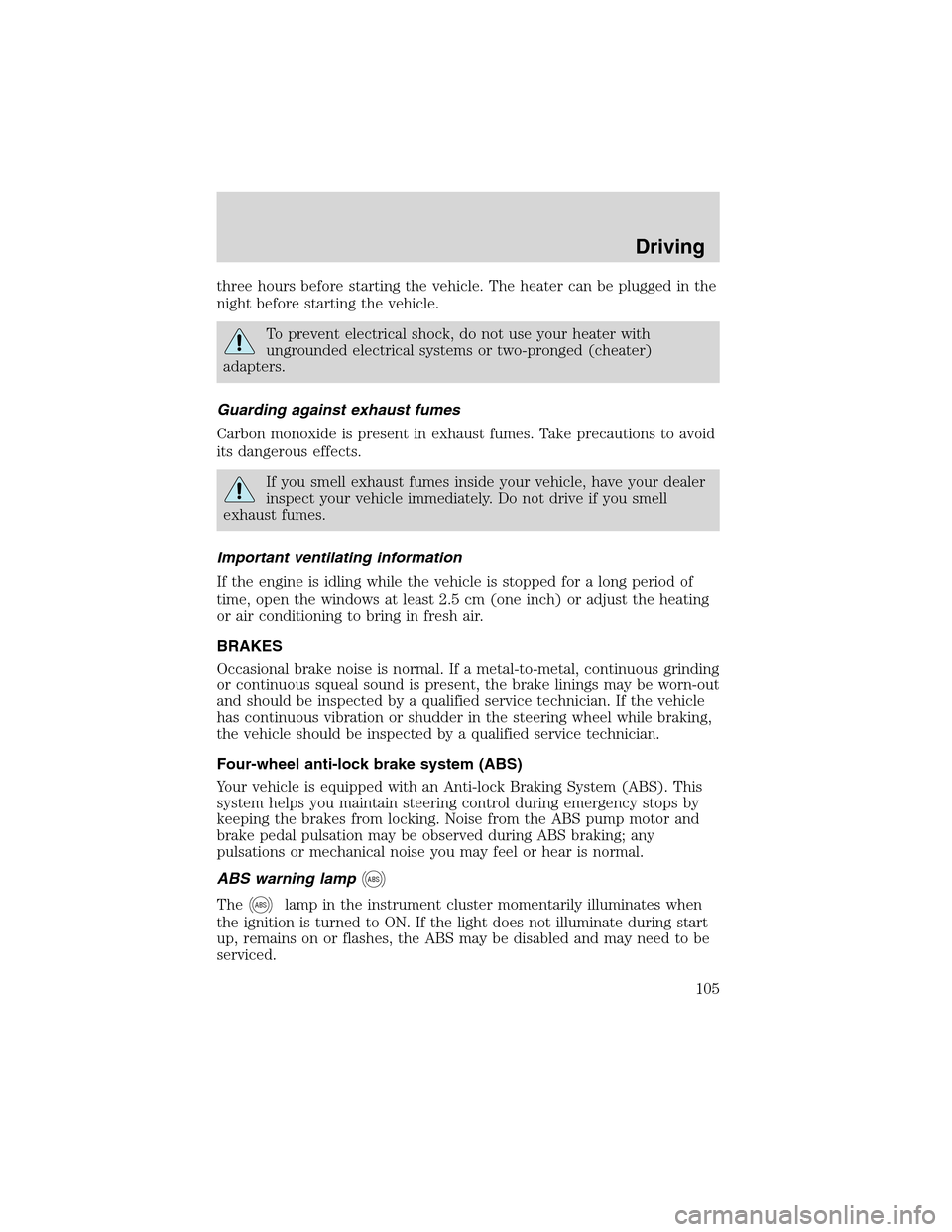
three hours before starting the vehicle. The heater can be plugged in the
night before starting the vehicle.
To prevent electrical shock, do not use your heater with
ungrounded electrical systems or two-pronged (cheater)
adapters.
Guarding against exhaust fumes
Carbon monoxide is present in exhaust fumes. Take precautions to avoid
its dangerous effects.
If you smell exhaust fumes inside your vehicle, have your dealer
inspect your vehicle immediately. Do not drive if you smell
exhaust fumes.
Important ventilating information
If the engine is idling while the vehicle is stopped for a long period of
time, open the windows at least 2.5 cm (one inch) or adjust the heating
or air conditioning to bring in fresh air.
BRAKES
Occasional brake noise is normal. If a metal-to-metal, continuous grinding
or continuous squeal sound is present, the brake linings may be worn-out
and should be inspected by a qualified service technician. If the vehicle
has continuous vibration or shudder in the steering wheel while braking,
the vehicle should be inspected by a qualified service technician.
Four-wheel anti-lock brake system (ABS)
Your vehicle is equipped with an Anti-lock Braking System (ABS). This
system helps you maintain steering control during emergency stops by
keeping the brakes from locking. Noise from the ABS pump motor and
brake pedal pulsation may be observed during ABS braking; any
pulsations or mechanical noise you may feel or hear is normal.
ABS warning lamp
ABS
TheABSlamp in the instrument cluster momentarily illuminates when
the ignition is turned to ON. If the light does not illuminate during start
up, remains on or flashes, the ABS may be disabled and may need to be
serviced.
Driving
105
Page 163 of 200
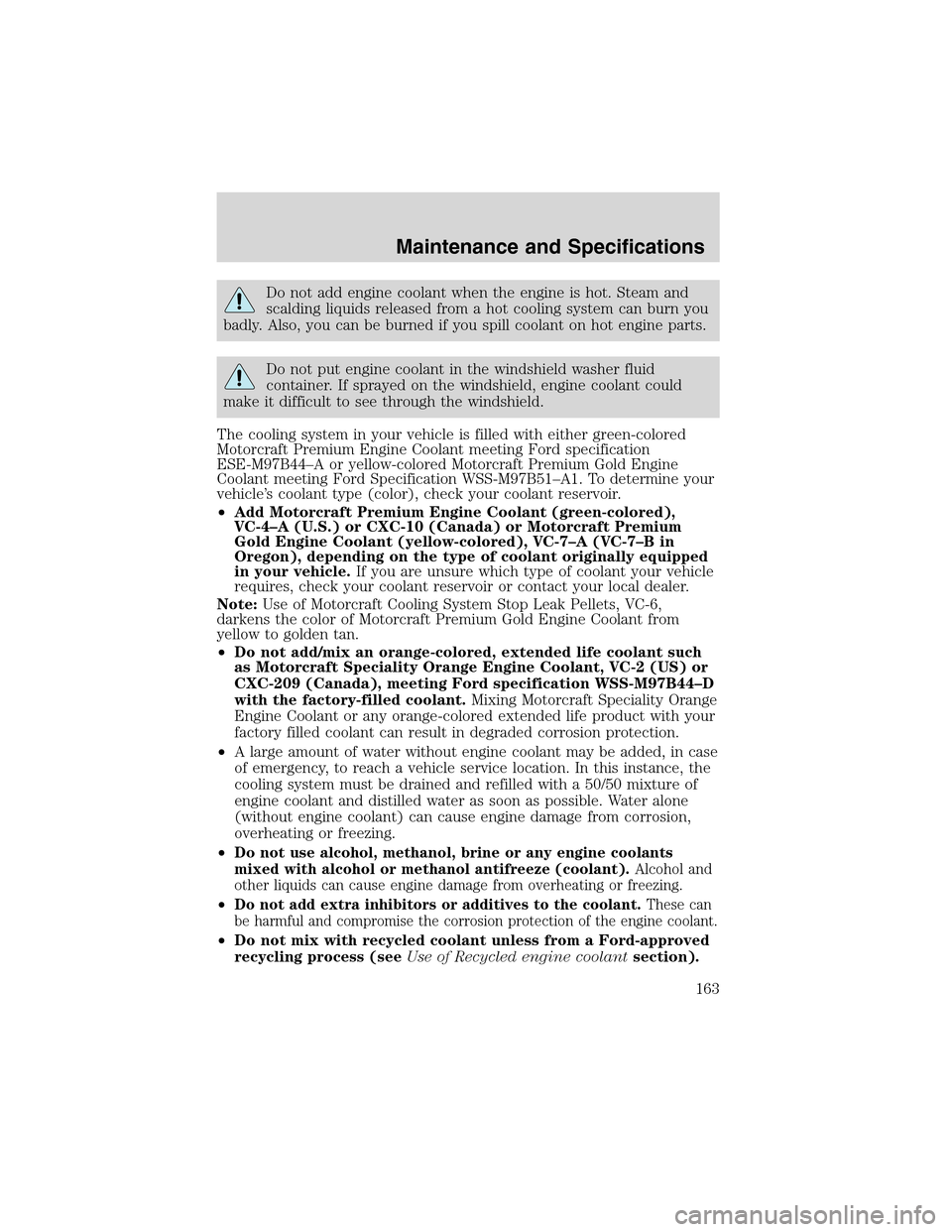
Do not add engine coolant when the engine is hot. Steam and
scalding liquids released from a hot cooling system can burn you
badly. Also, you can be burned if you spill coolant on hot engine parts.
Do not put engine coolant in the windshield washer fluid
container. If sprayed on the windshield, engine coolant could
make it difficult to see through the windshield.
The cooling system in your vehicle is filled with either green-colored
Motorcraft Premium Engine Coolant meeting Ford specification
ESE-M97B44–A or yellow-colored Motorcraft Premium Gold Engine
Coolant meeting Ford Specification WSS-M97B51–A1. To determine your
vehicle’s coolant type (color), check your coolant reservoir.
•Add Motorcraft Premium Engine Coolant (green-colored),
VC-4–A (U.S.) or CXC-10 (Canada) or Motorcraft Premium
Gold Engine Coolant (yellow-colored), VC-7–A (VC-7–Bin
Oregon), depending on the type of coolant originally equipped
in your vehicle.If you are unsure which type of coolant your vehicle
requires, check your coolant reservoir or contact your local dealer.
Note:Use of Motorcraft Cooling System Stop Leak Pellets, VC-6,
darkens the color of Motorcraft Premium Gold Engine Coolant from
yellow to golden tan.
•Do not add/mix an orange-colored, extended life coolant such
as Motorcraft Speciality Orange Engine Coolant, VC-2 (US) or
CXC-209 (Canada), meeting Ford specification WSS-M97B44–D
with the factory-filled coolant.Mixing Motorcraft Speciality Orange
Engine Coolant or any orange-colored extended life product with your
factory filled coolant can result in degraded corrosion protection.
•A large amount of water without engine coolant may be added, in case
of emergency, to reach a vehicle service location. In this instance, the
cooling system must be drained and refilled with a 50/50 mixture of
engine coolant and distilled water as soon as possible. Water alone
(without engine coolant) can cause engine damage from corrosion,
overheating or freezing.
•
Do not use alcohol, methanol, brine or any engine coolants
mixed with alcohol or methanol antifreeze (coolant).
Alcohol and
other liquids can cause engine damage from overheating or freezing.
•Do not add extra inhibitors or additives to the coolant.These can
be harmful and compromise the corrosion protection of the engine coolant.
•Do not mix with recycled coolant unless from a Ford-approved
recycling process (seeUse of Recycled engine coolantsection).
Maintenance and Specifications
163
Page 164 of 200
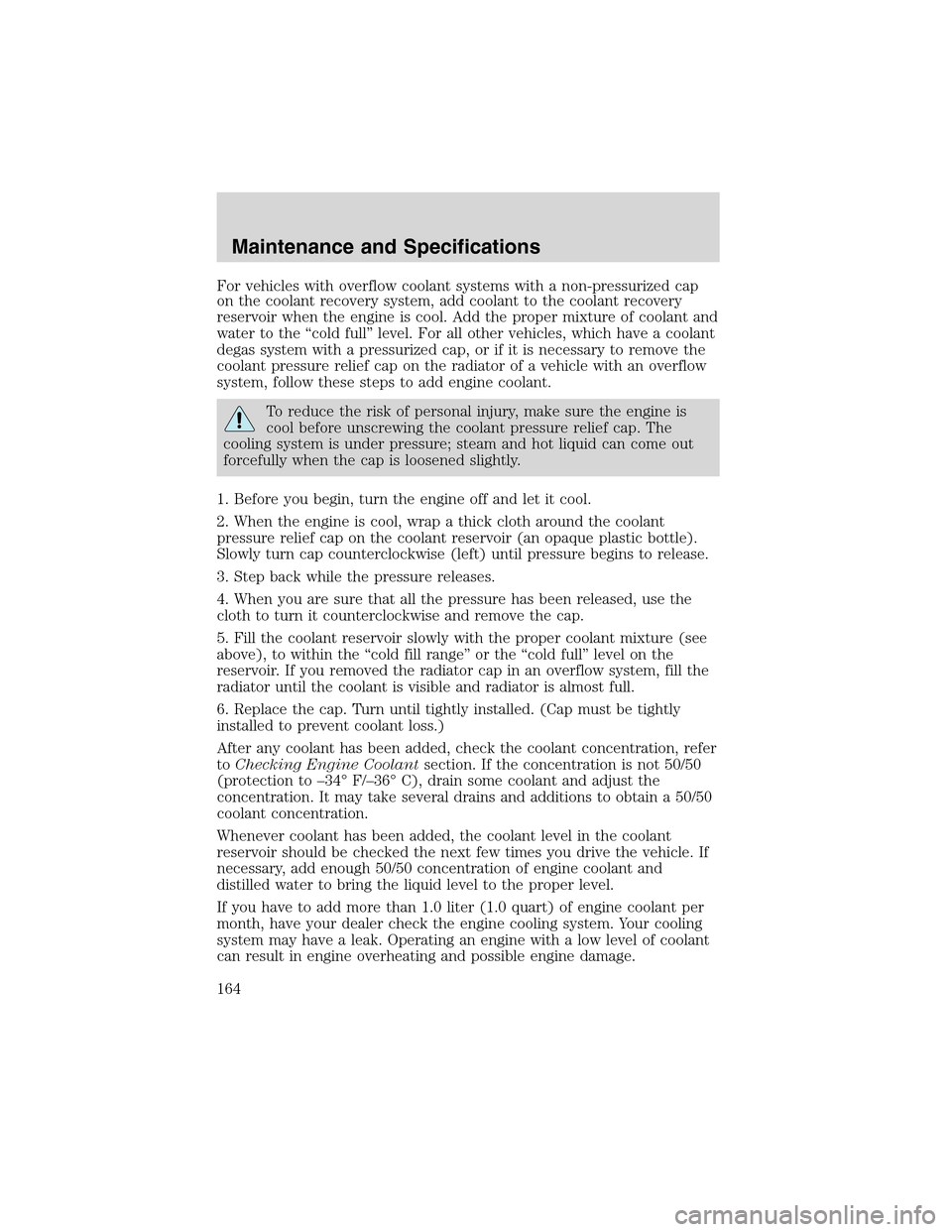
For vehicles with overflow coolant systems with a non-pressurized cap
on the coolant recovery system, add coolant to the coolant recovery
reservoir when the engine is cool. Add the proper mixture of coolant and
water to the“cold full”level. For all other vehicles, which have a coolant
degas system with a pressurized cap, or if it is necessary to remove the
coolant pressure relief cap on the radiator of a vehicle with an overflow
system, follow these steps to add engine coolant.
To reduce the risk of personal injury, make sure the engine is
cool before unscrewing the coolant pressure relief cap. The
cooling system is under pressure; steam and hot liquid can come out
forcefully when the cap is loosened slightly.
1. Before you begin, turn the engine off and let it cool.
2. When the engine is cool, wrap a thick cloth around the coolant
pressure relief cap on the coolant reservoir (an opaque plastic bottle).
Slowly turn cap counterclockwise (left) until pressure begins to release.
3. Step back while the pressure releases.
4. When you are sure that all the pressure has been released, use the
cloth to turn it counterclockwise and remove the cap.
5. Fill the coolant reservoir slowly with the proper coolant mixture (see
above), to within the“cold fill range”or the“cold full”level on the
reservoir. If you removed the radiator cap in an overflow system, fill the
radiator until the coolant is visible and radiator is almost full.
6. Replace the cap. Turn until tightly installed. (Cap must be tightly
installed to prevent coolant loss.)
After any coolant has been added, check the coolant concentration, refer
toChecking Engine Coolantsection. If the concentration is not 50/50
(protection to–34°F/–36°C), drain some coolant and adjust the
concentration. It may take several drains and additions to obtain a 50/50
coolant concentration.
Whenever coolant has been added, the coolant level in the coolant
reservoir should be checked the next few times you drive the vehicle. If
necessary, add enough 50/50 concentration of engine coolant and
distilled water to bring the liquid level to the proper level.
If you have to add more than 1.0 liter (1.0 quart) of engine coolant per
month, have your dealer check the engine cooling system. Your cooling
system may have a leak. Operating an engine with a low level of coolant
can result in engine overheating and possible engine damage.
Maintenance and Specifications
164
Page 192 of 200
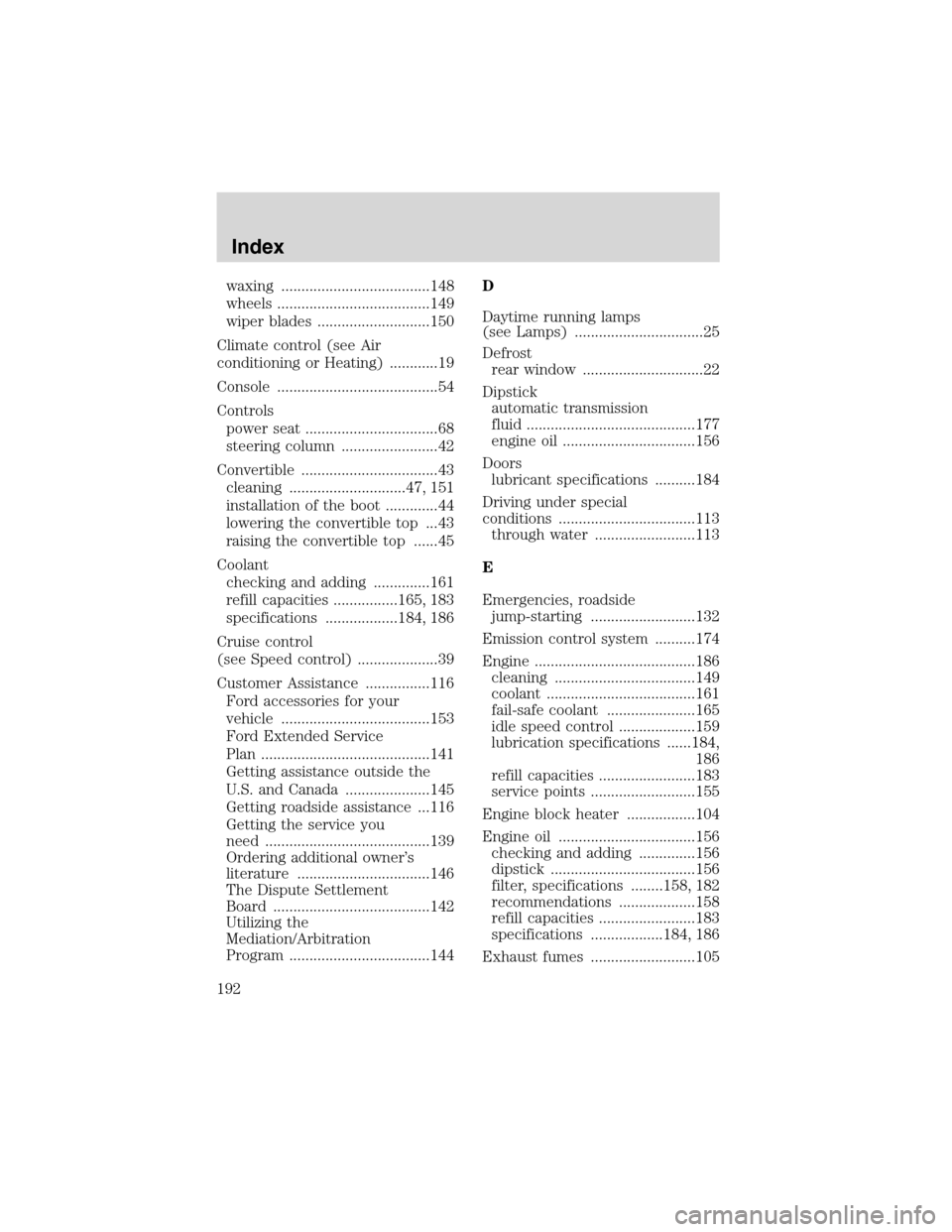
waxing.....................................148
wheels ......................................149
wiper blades ............................150
Climate control (see Air
conditioning or Heating) ............19
Console ........................................54
Controls
power seat .................................68
steering column ........................42
Convertible ..................................43
cleaning .............................47, 151
installation of the boot .............44
lowering the convertible top ...43
raising the convertible top ......45
Coolant
checking and adding ..............161
refill capacities ................165, 183
specifications ..................184, 186
Cruise control
(see Speed control) ....................39
Customer Assistance ................116
Ford accessories for your
vehicle .....................................153
Ford Extended Service
Plan ..........................................141
Getting assistance outside the
U.S. and Canada .....................145
Getting roadside assistance ...116
Getting the service you
need .........................................139
Ordering additional owner’s
literature .................................146
The Dispute Settlement
Board .......................................142
Utilizing the
Mediation/Arbitration
Program ...................................144D
Daytime running lamps
(see Lamps) ................................25
Defrost
rear window ..............................22
Dipstick
automatic transmission
fluid ..........................................177
engine oil .................................156
Doors
lubricant specifications ..........184
Driving under special
conditions ..................................113
through water .........................113
E
Emergencies, roadside
jump-starting ..........................132
Emission control system ..........174
Engine ........................................186
cleaning ...................................149
coolant .....................................161
fail-safe coolant ......................165
idle speed control ...................159
lubrication specifications ......184,
186
refill capacities ........................183
service points ..........................155
Engine block heater .................104
Engine oil ..................................156
checking and adding ..............156
dipstick ....................................156
filter, specifications ........158, 182
recommendations ...................158
refill capacities ........................183
specifications ..................184, 186
Exhaust fumes ..........................105
Index
192
Page 193 of 200
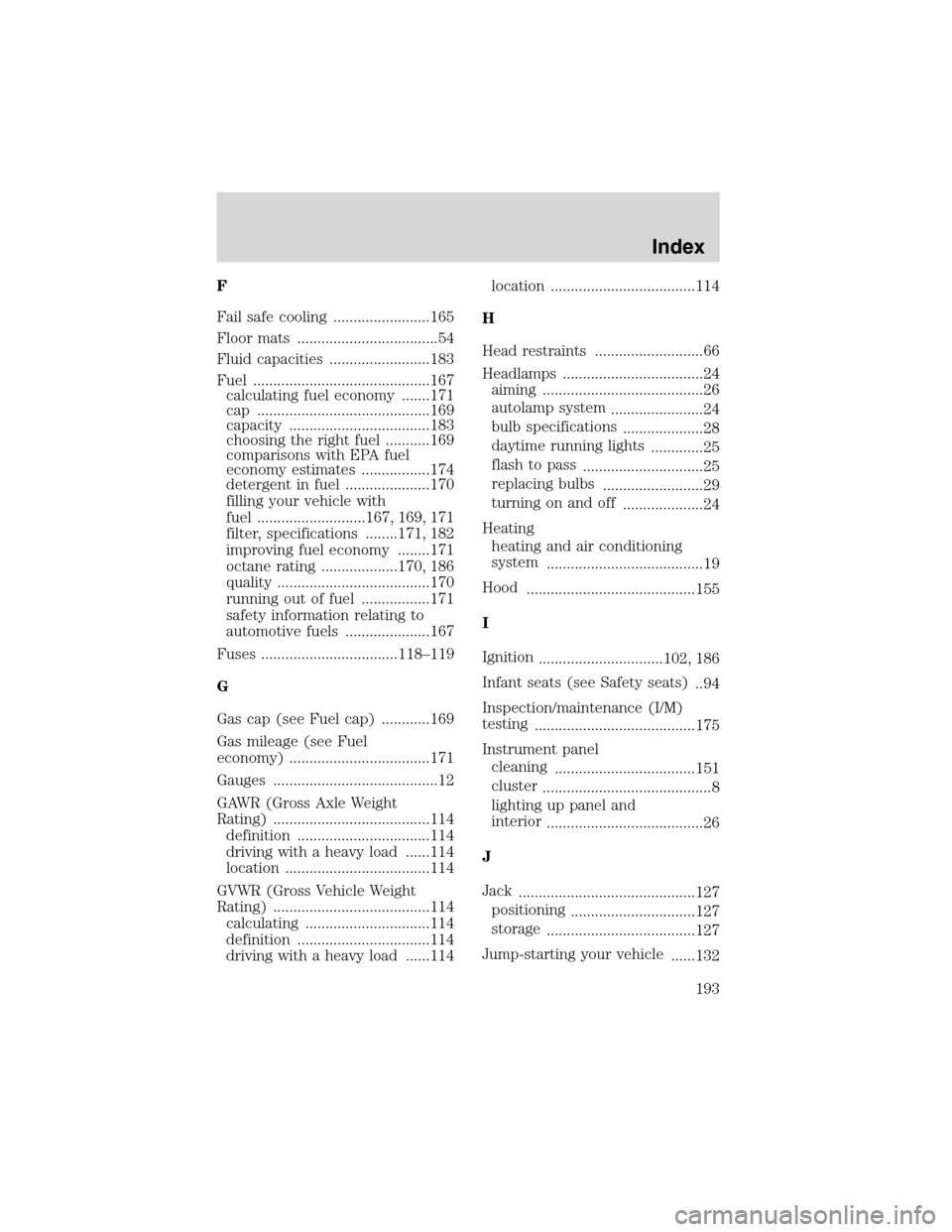
F
Fail safe cooling ........................165
Floor mats ...................................54
Fluid capacities .........................183
Fuel ............................................167
calculating fuel economy .......171
cap ...........................................169
capacity ...................................183
choosing the right fuel ...........169
comparisons with EPA fuel
economy estimates .................174
detergent in fuel .....................170
filling your vehicle with
fuel ...........................167, 169, 171
filter, specifications ........171, 182
improving fuel economy ........171
octane rating ...................170, 186
quality ......................................170
running out of fuel .................171
safety information relating to
automotive fuels .....................167
Fuses ..................................118–119
G
Gas cap (see Fuel cap) ............169
Gas mileage (see Fuel
economy) ...................................171
Gauges .........................................12
GAWR (Gross Axle Weight
Rating) .......................................114
definition .................................114
driving with a heavy load ......114
location ....................................114
GVWR (Gross Vehicle Weight
Rating) .......................................114
calculating ...............................114
definition .................................114
driving with a heavy load ......114location ....................................114
H
Head restraints ...........................66
Headlamps ...................................24
aiming ........................................26
autolamp system
.......................24
bulb specifications
....................28
daytime running lights
.............25
flash to pass
..............................25
replacing bulbs
.........................29
turning on and off
....................24
Heating
heating and air conditioning
system
.......................................19
Hood
..........................................155
I
Ignition
...............................102, 186
Infant seats (see Safety seats)
..94
Inspection/maintenance (I/M)
testing
........................................175
Instrument panel
cleaning
...................................151
cluster
..........................................8
lighting up panel and
interior
.......................................26
J
Jack
............................................127
positioning
...............................127
storage
.....................................127
Jump-starting your vehicle
......132
Index
193